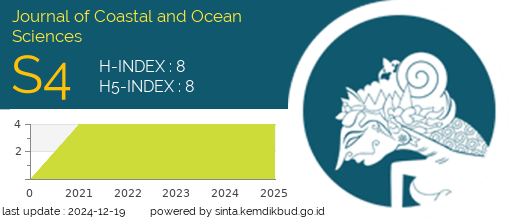Types and Abundance of Microplastics in the Digestive Tract of Cucumbers in Banyak Island, Aceh Singkil
DOI:
https://doi.org/10.31258/jocos.5.2.81-85Keywords:
Sea cucumbers, Banyak Island, MicroplasticsAbstract
Banyak Island is an island located in Aceh province, precisely in Aceh Singkil district. The people of Banyak Island often consume food whose packaging is made of plastic, and then it ends up in the sea. Island community waste thrown into the sea will enter and potentially pollute the marine ecosystem and the biota within it. This research aims to identify the type of composition and abundance of microplastics found in the digestive tract of sea cucumbers on Banyak Island, Aceh Singkil, in terms of the shape and abundance of microplastics. The method used in this research is a descriptive analysis method, which is based on photos taken with a microscope. Based on the research results, the species composition ranged from 50-114 particles/g, and the abundance of microplastics obtained was 0.2-11.4 particles/g. It was dominated by microplastic pellets, fibers, and films, with the pellet type being the first. Judging from the large amount of microplastic content found in the digestive tract of sea cucumbers on Banyak Island, Aceh Singkil, they can be categorized into types of sea cucumbers that are still suitable for consumption and sale, but if done continuously, can trigger the growth of if done frequently and over a long period, it will cause adverse effects for humans who consume it
Downloads
References
Asia, M.Z. (2017). Impact of Plastic Waste on Marine Ecosystems. Matric Bulletin, 14(1): 44–48.
Ayuningtyas, W., Yona, D., & Iranawati, F. (2019). Abundance of Microplastics in Water in Banyuurip, Gresik, East Java. Journal of Fisheries and Marine Research, 3(1): 41-45.
Cózar, A., Sanz-Martin, M., Marti, E., Gonzáles-Gordillo, J.I., Gálve, B., Ubeda, J.A., & Duarte, C.M. (2015). Plastic Accumulation in the Mediterranean Sea. Plos One. Saudi Arabia.
Ebere C.E., Verla, W.A., Verla, E.N., & Chukwuemeka, I.S. (2019). Macrodebris and Microplastic Pollution in Nigeria: First Report on Abundance, Distribution, and Composition. Environmental Analysis Health and Toxicology, 34(4): 1–15.
Gesamp, G. (2019). Guidelines for the Monitoring and Assessment of Plastic Litter in the Ocean. Journal series GESAMP Reports and Studies, 99(130).
Kenny, A. (2019). Analysis of the Abundance of Microplastics in Water and Mullet Fish (Mugil chephalus) in the Wonorojo River, Surabaya, East Java. Brawijaya University.
Laila, Q.N., Pujiono, W.P., & Oktavianto, E.J. (2020). Kelimpahan Mikroplastik pada Sedimen di Desa Mangunharjo, Kecamatan Tugu, Kota Semarang. Jurnal Pasir Laut, 4(1): 28-35.
Lusher, A.L., Welden, N.A., Sobral, P., & Cole, M. (2016). Sampling Isolating, Identifying Macroplastics Ingested by Fish and Invertebrates. Journal Analytical Methods:1-33.
Melindo, H., Riani, E., & Sinambela, C. (2022). Microplastic Treats in the Cultured of Sandfish (Holothurian scabra): A Case Study of Pasar Island, Banda Lampung. Coastal and Ocean Journal, 6(2): 73-80.
Miller, M.E., Hamann, M., & Kroon, F.J. (2020). Biomagnification of Microplastics in Marine Organisms: A Review and Meta-Analysis of Current Data. PLoS One, 15(10): 1-25.
Mohsen, M., Wang, Q., Zhang, L., Sun, L., Lin, C., & Yang, H. (2018). Microplastic Ingestion by the Farmed Sea Cucumber Apostichopus japonicus in China. Environ., 245: 1071– 1078.
Rahman, A.G. (2021). Identifikasi Jenis Mikroplastik pada Teripang dari Area Padang Lamun di Kepulauan Spermonde Kota Makassar. Universitas Hasanuddin. Makassar.
Riani, E., Chairunnisa, C., Maheswari, H., Dzikrifishofa, M., & Kusumorini, N. (2016). Sandfish (Holothuria scabra) Ameliorates Aging in Menopausal Women by Increasing Estradiol Hormones. Physiology and Pharmacology Journal, 20(3): 206-214.
Sayogo, B.H., Patria, M.P., & Takarina, N. D. (2020). The Density of Microplastics in Sea Cucumber (Holothuria sp.) and Sediment at Tidung Besar and Bira Besar Island, Jakarta. Journal of Physics: Conference Series, 1524 012064: 1-6.
Wagner, M., & Lambert, S. (2018). Freshwater Microplastic Emerging Environmental Contaminants. Switzerland: Springer open.






